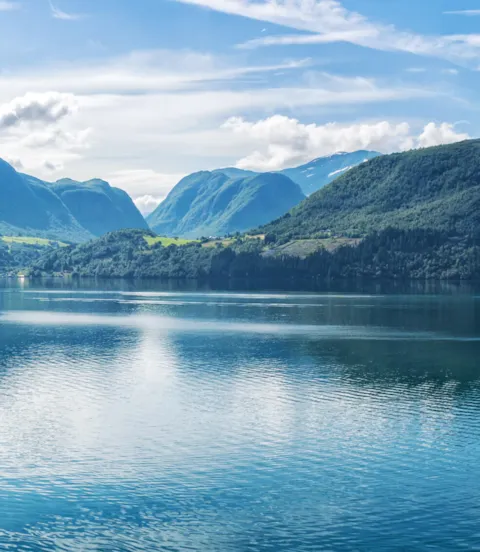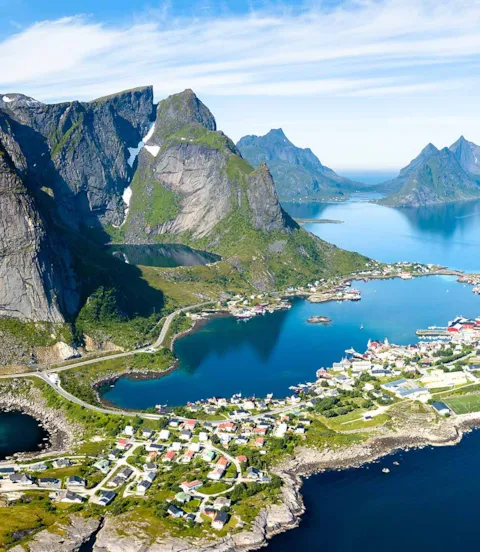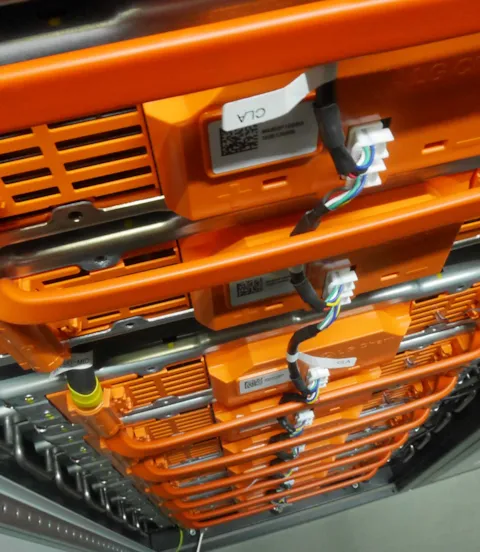Someone has to go first
As the world’s leader in marine battery solutions, Norway is working to become the first country to electrify coastal transportation. And while there is still a long road ahead, Norway has a genuine advantage: A network of stakeholders working together to make it happen.
Increasing public concerns about the environment have led to a growing sense of urgency for Norway’s government and industry to act to slow climate change and improve air quality along its 2,650 km coastline. And with Norwegian domestic shipping contributing about nine per cent of Norway’s total carbon dioxide (CO2) emissions, 34 per cent of its nitrogen oxide (NOX) emissions and 25 per cent of its sulphur oxide (SOX) emissions, shipping has been identified as a key part of the clean air challenge.

Mandate to act
According to Sveinung Oftedal, Specialist Director for Norway’s Department for Marine Management and Pollution Control, Norway is in a unique position to take the lead on zero emissions coastal shipping. “Norwegians prize the natural beauty of their country and many rely on ocean industries for their livelihood, so it is easy to understand why Norwegian politicians take actions towards green shipping,” he says. “Second, Norway has one of the world’s most complete maritime clusters in the world, so we have the technology. And finally, Norway has the resources to help incentivize stakeholders to create public-private partnerships to accelerate our transition to clean energy.”
Oftedal acknowledges that like many big industrial shifts, innovation often follows regulation. “In addition to establishing our own domestic goals, Norway has worked closely with the UN, IMO and the EU which all share our commitment to reducing emissions,” he says. “For example, as signatories to the Gothenburg Protocol, Norway has agreed to reduce emissions of SOX by 59 per cent, NOX by 42 per cent, ammonia (NH3) by six per cent, volatile organic compounds (VOCs) by 28 per cent and particulate matter (PM) by 22 per cent. To meet some of these targets, we have to look at shipping.”

Public-private cooperation
Rather than simply announcing new regulations and hoping for the best, the government has reached out to the private sector. In 2008, the Ministry of Climate and Environment announced an agreement with 18 of Norway’s largest business organizations to create the NOX Fund, established to help finance cost-effective emissions reductions. Companies can also apply for grants from Enova, another Ministry initiative which makes public resources available for investments in green solutions. Other programmes, such as Innovation Norway and the Norwegian Research Council’s ENERGIX programme, provide funding for research, including renewable energy and efficient energy systems.
The government has also signalled its focus on coastal shipping. In January 2015, the Minister of Trade and Industry Monica Mæland and State Secretary for Climate and Environment Lars Andreas Lunde signed a declaration of cooperation with key players in the Norwegian coastal shipping industry. Known as the Green Coastal Programme, the initiative (developed in cooperation with DNV GL) establishes a partnership between private and public authorities to implement the government’s maritime and port strategy.
Norwegian shipping companies have long been recognized as pioneers in developing green technologies. For example, Norwegian owners were among the first to develop hybrid gas-fuelled vessels and are leading the development of hydrogen-powered vessels. But for many short-sea operators, batteries are the future. Battery solutions not only drastically cut emissions in ports and at sea, but they can be charged using Norway’s domestic energy grid, which is derived from clean, renewable hydropower. It is perhaps no surprise that of the 250 battery hybrid vessels either sailing or on order, about 40 per cent are Norwegian.

First movers
While the Green Coastal Programme applies to all types of tonnage, the first movers have been the ferry operators, who compete for routes administered by both federal and municipal agencies. According to Arild Austrheim, Head of Newbuildings for Fjord1, Norway’s leading ferry operator, the tendering process requires that operators invest in low or zero emissions vessels. “There are about 116 ferry routes in Norway, so to compete for these contracts, we have to show that we are committed to reducing emissions,” he says. “That’s why all the ferries in our 25-vessel newbuilding programme are electric.”
Austrheim acknowledges that regulations are the primary driver for change, but he notes that it is the industry’s willingness to develop and embrace new technologies that will make the difference. “In 2010, Fjord1 launched the Fannefjord, an LNG hybrid ferry which we converted into an LNG battery hybrid in 2016, so we already have a strong track record for trying out new systems,” he says. “It is a mistake to assume owners are dragging their feet. In fact, the development of new technology is moving so fast, government agencies sometimes struggle to keep up.”

Ground zero
By some estimates, the marine battery market will double by 2020, when about 80 per cent of new based coastal vessels will include some form of battery operation. Halvard Hauso, Executive
Vice President Sales & Marketing for Corvus, a NorwegianCanadian-based battery manufacturer, says that his company is scaling up to meet demand. “We are in the process upgrading to semi-automated battery manufacturing in Canada, and have announced the construction of a fully-automated battery factory and research centre in Bergen,” he says. “We already have a long track record of providing battery solutions to ferries and offshore supply vessels, and are now seeing demand rise in all kinds of shipping segments. But the largest growth potential for us in Norway is cruise, ro-pax ferries and ro-ro ferries.”
Hauso says that while this demand is related to meeting domestic emissions reduction targets, the company’s decision to invest in Bergen had more to do with being part of one of the world’s most advanced and dynamic maritime clusters. “Norway is the place to be for battery technology,” he says. “Working so closely with global leaders in marine battery solutions helps drive competition and innovation. For example, in less than two years, we have managed to cut the size and cost of our latest battery in half, without losing any storage capacity.”

Export potential
Other key players in the development of marine battery solutions are systems integrators such as Siemens, ABB, Wärtsilä and Rolls-Royce – all companies with a strong presence in Norway. Jens Hjorteset, Product Manager Energy Storage Systems at RollsRoyce, says the company has been delivering complete energy management systems since 2010. “We have and will continue to work with other battery manufacturers, but we also identified market demand for complete systems,” he says. “Recently, we partnered with Color Line, Norled and the Norwegian Coastal Administration shipping company to develop SAVe Energy, a modular, liquid-cooled battery system that can be scaled according to a vessel’s energy and power requirements.”
While designed for ro-pax ferries, Hjorteset notes that the SAVe Energy system can be applied to a wide variety of marine applications, including cruise vessels and multi-purpose vessels. “Most of this development is occurring in Norway, but we see demand for battery systems rising all over the world – especially in Asia,” he says. “Domestically, our business is driven by regulation, but winning contracts overseas will require that we make a stronger business case for electrified marine transport.”

The role of class
As with any type of tonnage, the responsibility making sure these new technologies are safe and reliable falls to class societies. But according to Sondre Henningsgård, Discipline Leader & Digital Head in Maritime Advisory at DNV GL, they play a special role. “In addition to issuing type approvals and verification services, DNV GL is active in bringing different stakeholders together,” he says. “For example, my colleague Narve Mjøs currently serves as Programme Director for the Green Coastal Programme and DNV GL is a member of NCE Maritime CleanTech, a research centre devoted to developing clean energy solutions, located south of Bergen. DNV GL is also involved in a number of joint industry projects to foster development.”
Henningsgård himself serves as the Managing Director for the Maritime Battery Forum. Established in 2014 the Forum brings together a broad range of stakeholders to solve common challenges. “While the pace of development in battery technology, including recycling or repurposing old batteries, and onboard power management systems has exceeded expectations, shore-based infrastructure remains a challenge,” he says. “At the same time, most of the projects we are seeing are hybrids with engines and batteries, where the battery helps optimize the way the machinery is used.”
Henningsgård adds that because port facilities are managed locally, owners face different conditions depending on where they operate. While some ports are working with owners to install charging stations, there are many discussions about technical standards, where to build shore-based infrastructure and who pays for what. And in some areas, local electrical grids may not be prepared to provide adequate power, creating another potential roadblock.

More needs to be done
Jan Kjetil Paulsen, Senior Advisor for Bellona (a Norwegian NGO), is encouraged by Norway’s commitment to zero emissions coastal shipping but he believes more needs to be done to accelerate the country’s green shift. “The electrification of ferries, sightseeing vessels and coastal fishing boats will make an impact, but these vessels usually operate on fixed, point-to-point routes or have a limited operation area and represent only a small fraction of Norway’s coastal shipping fleet,” he says. “Owners of other types of tonnage, such as coastal bulk carriers, fishing trawlers, container ships and tankers, are responsible for most of Norway’s coastal emissions but may not have the resources or the right incentives to assume the high CAPEX costs required to convert to battery hybrid solutions.”
Like many in the industry, Paulsen is concerned that without a coordinated strategy and sufficient funding for shore-based infrastructure, upgrading local electrical grids and introducing common standards for shore power charging stations, the domestic shipping industry may not be able to contribute its fair share to the defined national targets for reduced emissions. “The technology for zero emission shipping is evolving very quickly, but the lack of in-port infrastructure required to supply renewable energy in various forms remains an obstacle for rolling out this technology in a scale that will make an impact,” he says. ”This is not an issue for ferry operators on fixed eight to ten-year contracts, but for other types of tonnage, it is a genuine concern.”
While the number of Norwegian ports offering (or are planning to offer) shore power for electrified ships is growing every year, Paulsen says there is still no coordinated national strategy to build out the infrastructure. “The reason Norway has more electric cars per capita than any other nation is because the government got behind efforts to build charging stations along Norway’s road networks,” he says. “While ship electrification is more complex, this same approach should be applied to ports.”

Good timing
Despite these challenges, Norway’s green shift in coastal shipping comes at a good time. Because of a slowdown in the offshore industry, Norwegian shipyards have the capacity to take orders for electric and hybrid-powered tonnage, and with more and more countries seeking to lower coastal emissions, Norway’s worldleading expertise in marine battery technology may attract more overseas business, creating jobs.
For example, in May of this year, US-based Washington State Ferries announced plans to convert its three largest vessels from running on diesel fuel to electric power. To provide support, DNV GL recently brought representatives from the Norwegian Maritime Authority, Norway’s Maritime CleanTech cluster, the Norwegian Embassy and the Confederation of Norwegian Enterprises to Seattle to meet with Washington State officials to share their experience in maritime battery technology and shoreside charging.
Time will tell if Norway can achieve its ambitious coastal emissions reduction targets. But as a “first mover” in marine battery technology, some worry that without more government support, Norway may miss its opportunity to industrialize its technological advantage, as it has in the offshore industry. But for now at least, Norway is racing ahead – as cleanly and quietly as an electric car.